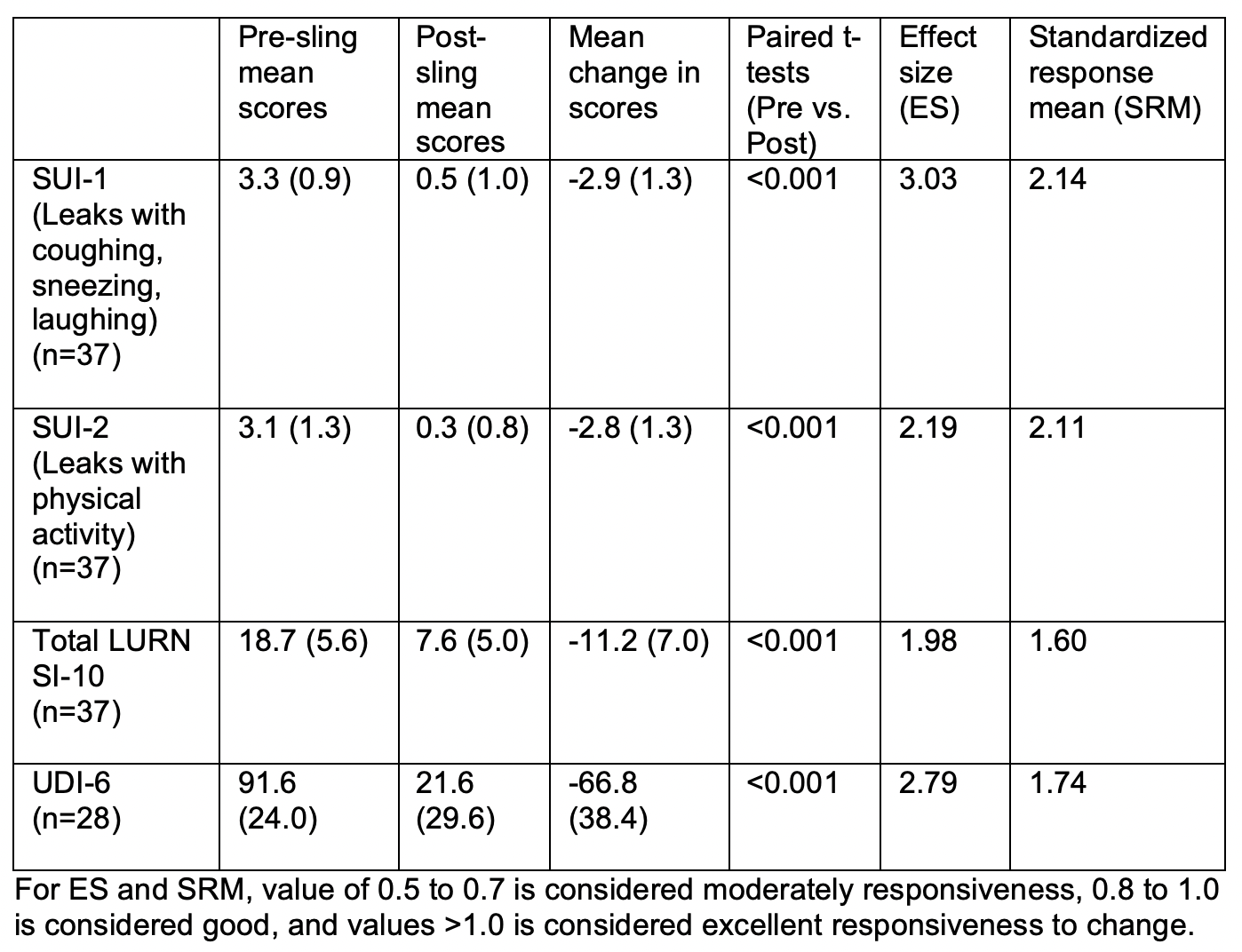Back
Introduction: The LURN SI-10 (10-item LURN Symptom Index) was developed by the Symptoms of Lower Urinary Tract Dysfunction Research Network (LURN) to measure LUTS in men and women (Cella et al 2019). LURN SI-10 consists of ten items on LUTS, plus an additional question on global urinary bother. Two of the items focus on stress urinary incontinence with coughing/sneezing/laughing (SUI-1), and SUI with physical activities (SUI-2). Here we validate and evaluate the responsiveness of the LURN SI-10 questionnaire by comparing patients’ responses before and after midurethral sling surgery.
Methods: Adult women completed the LURN SI-10 and Urinary Distress Inventory (UDI-6) questionnaires before and after midurethral sling surgery (retropubic or trans-obturator TVT). Mean change in total LURN SI-10, SUI-1 and SUI-2 scores after surgery, paired t-tests, effect sizes (ES) of the change, and standardized response means (SRM) were tabulated. For ES and SRM, value of 0.5 to 0.7 is considered moderate responsiveness, 0.8 to 1.0 is considered good, and values >1.0 is considered excellent responsiveness to change. LURN SI-10 scores were compared to scores on the UDI-6.
Results: Total LURN SI-10, SUI-1 and SUI-2 scores on LURN SI-10 decreased by 59%, 85% and 90% respectively after midurethral sling surgeries (n=37, all p<0.001, paired t-tests, see Table). The effect sizes (ES) of the changes for SUI-1 and SUI-2 were 3.03 and 2.19 respectively, indicating excellent responsiveness to change to known effective treatments of SUI. The standardized response means (SRM) were 2.14 and 2.11 respectively, again indicating excellent responsiveness to change. The ES of SUI-1 was greater than the ES of UDI-6. The SRM of SUI-1 and SUI-2 were both greater than UDI-6. There were strong correlations between LURN SI-10 and UDI-6 before and after surgery (r=0.84 and 0.65 respectively, p both <0.01).
Conclusions: The two stress urinary incontinence questions (SUI-1, SUI-2) on LURN SI-10 questionnaire were responsive to change to known effective treatments of SUI, and may be used to assess SUI symptom change or improvement after SUI treatments. SOURCE OF
Funding: Midwest Stone Institute

Moderated Poster Session
Session: MP37: Urodynamics/Lower Urinary Tract Dysfunction/Female Pelvic Medicine: Female Incontinence: Therapy II
MP37-06: VALIDATION OF THE LURN SI-10 QUESTIONNAIRE IN WOMEN UNDERGOING MIDURETHRAL SLING SURGERY
Saturday, April 29, 2023
1:00 PM – 3:00 PM CST
Location: S401A

Henry Henry Lai, MD
Professor of Urology and Anesthesiology
Washington University School of Medicine
Poster Presenter(s)
Introduction: The LURN SI-10 (10-item LURN Symptom Index) was developed by the Symptoms of Lower Urinary Tract Dysfunction Research Network (LURN) to measure LUTS in men and women (Cella et al 2019). LURN SI-10 consists of ten items on LUTS, plus an additional question on global urinary bother. Two of the items focus on stress urinary incontinence with coughing/sneezing/laughing (SUI-1), and SUI with physical activities (SUI-2). Here we validate and evaluate the responsiveness of the LURN SI-10 questionnaire by comparing patients’ responses before and after midurethral sling surgery.
Methods: Adult women completed the LURN SI-10 and Urinary Distress Inventory (UDI-6) questionnaires before and after midurethral sling surgery (retropubic or trans-obturator TVT). Mean change in total LURN SI-10, SUI-1 and SUI-2 scores after surgery, paired t-tests, effect sizes (ES) of the change, and standardized response means (SRM) were tabulated. For ES and SRM, value of 0.5 to 0.7 is considered moderate responsiveness, 0.8 to 1.0 is considered good, and values >1.0 is considered excellent responsiveness to change. LURN SI-10 scores were compared to scores on the UDI-6.
Results: Total LURN SI-10, SUI-1 and SUI-2 scores on LURN SI-10 decreased by 59%, 85% and 90% respectively after midurethral sling surgeries (n=37, all p<0.001, paired t-tests, see Table). The effect sizes (ES) of the changes for SUI-1 and SUI-2 were 3.03 and 2.19 respectively, indicating excellent responsiveness to change to known effective treatments of SUI. The standardized response means (SRM) were 2.14 and 2.11 respectively, again indicating excellent responsiveness to change. The ES of SUI-1 was greater than the ES of UDI-6. The SRM of SUI-1 and SUI-2 were both greater than UDI-6. There were strong correlations between LURN SI-10 and UDI-6 before and after surgery (r=0.84 and 0.65 respectively, p both <0.01).
Conclusions: The two stress urinary incontinence questions (SUI-1, SUI-2) on LURN SI-10 questionnaire were responsive to change to known effective treatments of SUI, and may be used to assess SUI symptom change or improvement after SUI treatments. SOURCE OF
Funding: Midwest Stone Institute

